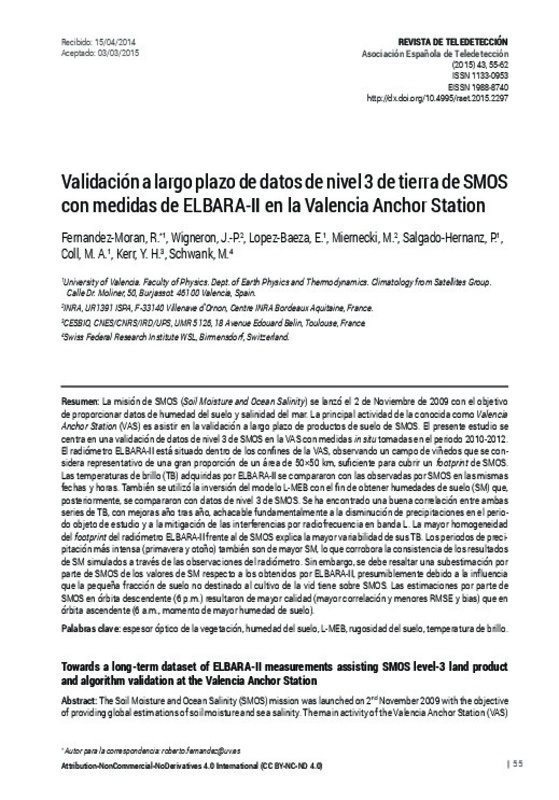|
Resumen:
|
[EN] The Soil Moisture and Ocean Salinity (SMOS) mission was launched on 2nd November 2009 with the objective of providing global estimations of soil moisture and sea salinity. The main activity of the Valencia Anchor ...[+]
[EN] The Soil Moisture and Ocean Salinity (SMOS) mission was launched on 2nd November 2009 with the objective of providing global estimations of soil moisture and sea salinity. The main activity of the Valencia Anchor Station (VAS) is currently to assist in a long-term validation of SMOS land products. This study focus on a level 3 SMOS data validation with in situ measurements carried out in the period 2010-2012 over the VAS. ELBARA-II radiometer is placed in the VAS area, observing a vineyard field considered as representative of a major proportion of an area of 50×50 km, enough to cover a SMOS footprint. Brightness temperatures (TB) acquired by ELBARA-II have been compared to those observed by SMOS at the same dates and time. They were also used for the L-MEB model inversion to retrieve soil moisture (SM), which later on have been compared to those provided by SMOS as level 3 data. A good correlation between both TB datasets was found, improving year by year, mainly due to the decrease of precipitations in the analyzed period and the mitigation of radio frequency interferences at L-band. The larger homogeneity of the radiometer footprint as compared to SMOS explains the higher variability of its TB. Periods of more intense precipitation (spring and autumn) also presented higher SM, which corroborates the consistency of SM retrieved from ELBARA-II’s observations. However, the results show that SMOS level 3 data underestimate SM as compared to ELBARA-II’s, probably due to the influence of the small soil fraction which is not cultivated in vineyards. SMOS estimations in descending orbit (6 pm) had better quality (higher correlation, lower RMSE and bias) than the ones in ascending orbit (6 am, when there is a higher soil moisture).
Guardar / Salir Siguiente >
[-]
[ES] La misión de SMOS (Soil Moisture and Ocean Salinity) se lanzó el 2 de Noviembre de 2009 con el objetivo de proporcionar datos de humedad del suelo y salinidad del mar. La principal actividad de la conocida como Valencia ...[+]
[ES] La misión de SMOS (Soil Moisture and Ocean Salinity) se lanzó el 2 de Noviembre de 2009 con el objetivo de proporcionar datos de humedad del suelo y salinidad del mar. La principal actividad de la conocida como Valencia Anchor Station(VAS) es asistir en la validación a largo plazo de productos de suelo de SMOS. El presente estudio se centra en una validación de datos de nivel 3 de SMOS en la VAS con medidas in situ tomadas en el periodo 2010-2012. El radiómetro ELBARA-II está situado dentro de los confines de la VAS, observando un campo de viñedos que se con-sidera representativo de una gran proporción de un área de 50×50 km, suficiente para cubrir un footprint de SMOS. Las temperaturas de brillo (TB) adquiridas por ELBARA-II se compararon con las observadas por SMOS en las mismas fechas y horas. También se utilizó la inversión del modelo L-MEB con el fin de obtener humedades de suelo (SM) que, posteriormente, se compararon con datos de nivel 3 de SMOS. Se ha encontrado una buena correlación entre ambas series de TB, con mejoras año tras año, achacable fundamentalmente a la disminución de precipitaciones en el perio-do objeto de estudio y a la mitigación de las interferencias por radiofrecuencia en banda L. La mayor homogeneidad del footprintdel radiómetro ELBARA-II frente al de SMOS explica la mayor variabilidad de sus TB. Los periodos de preci-pitación más intensa (primavera y otoño) también son de mayor SM, lo que corrobora la consistencia de los resultados de SM simulados a través de las observaciones del radiómetro. Sin embargo, se debe resaltar una subestimación por parte de SMOS de los valores de SM respecto a los obtenidos por ELBARA-II, presumiblemente debido a la influencia que la pequeña fracción de suelo no destinado al cultivo de la vid tiene sobre SMOS. Las estimaciones por parte de SMOS en órbita descendente (6 p.m.) resultaron de mayor calidad (mayor correlación y menores RMSE y bias) que en órbita ascendente (6 a.m., momento de mayor humedad de suelo).
[-]
|
|
Agradecimientos:
|
This work is carried out within the framework of the project MIDAS-7/UVEG Productos y Aplicaciones Avanzados de SMOS y Futuras Misiones (Parte UVEG) from the Spanish Research Programme on Space, Spanish Ministry
for Economy ...[+]
This work is carried out within the framework of the project MIDAS-7/UVEG Productos y Aplicaciones Avanzados de SMOS y Futuras Misiones (Parte UVEG) from the Spanish Research Programme on Space, Spanish Ministry
for Economy and Competitiveness.
[-]
|








